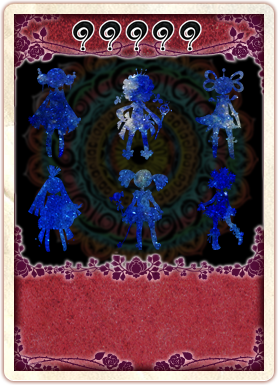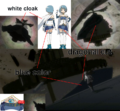Walpurgis Night
This section may contain major spoilers!
Please refrain from reading if you are not yet familiar with all the latest media released.Walpurgis Night (alternately referred to as "Walpurgisnacht" or "Walpurgis" both in the series and among fans) is supposedly the strongest witch current Magical Girls would have to fight. Her real name is unknown, while "Walpurgis Night" is a common moniker given to it by Puellae Magi. Her nature had been kept mysterious during most of the series, which led to a lot of speculation from fans during the original broadcast. This article's first purpose is, as with the other witches, to provide information about her.
The witch first appeared in the prologue "dream" sequence of Episode 1, although it wasn't called by any name back then. This led to some speculations about the witch's identity before it was finally revealed in Episode 10.
For a compilation of historical, mythological, and literary information concerning Walpurgisnacht (ワルプルギスの夜 Warupurugisu no Yoru, Night of Walpurgis), a term first mentioned by Homura in Episode 6, see Speculah:Walpurgis Night.
The set-constructing witch (alias: Walpurgis Night / real name: unknown); her nature is helplessness. She symbolizes the fool who continuously spins in circles. The witch's mysteries have been handed down through the course of history; her appellation is "Walpurgis Night." She will continue to rotate aimlessly throughout the world until she completely changes the whole of this age into a drama. When the doll's usual upside-down position reaches the top part of the witch, she completely roils the civilization on the ground in a flash through her gale-like flight. | |||||||||||
Minions
The set-constructing witch's minions. Their duty is to be clowns. Countless souls drawn to her vast magical power. Nobody knows whether Walpurgis Night was initially a single person, or if it was a phantom born from the gathering of many spirits. | |||||||||||
Trivia
- Walpurgis Night is named for Walpurgisnacht, a traditional spring festival celebrated on 30 April or 1 May in large parts of Central and Northern Europe. For more information on the festival's history, cultural and literary impacts, and connection to witchcraft, see Speculah: Walpurgis Night.
- Kyoko Sakura confirmed that Walpurgis was the most powerful witch in Episode 9; in Episode 10, however, Madoka Kaname eclipsed her in power in two of the timelines created by Homura Akemi, becoming the god-like Kriemhild Gretchen. Episode 11 showed that Walpurgis can withstand repeated attacks from heavy artillery, and her mere appearance can cause hundreds of deaths.
- While Walpurgis does not need to hide in a barrier, like other witches, her arrival in Mitakihara Town is preceded by a carnival-like procession of familiars. This is apparently a reflection of her theatrical theme, and possibly also evidence of her desire to transform the world into a giant "stage."
- The witch's most prominent familiars take the form of former magical girls, as evidenced by their resemblance to the puellae magi shown in the final scene of Episode 12.
- The manga version even takes this one step further by explicitly featuring the deceased Sayaka, Kyouko and Mami, all of which are main characters, as Walpurgis's minions.
- They also bear similiarity to characters from the music video of Maaya Sakamoto's Universe. This is unsurprising as both the MV and witch sequences are designed by animators Gekidan Inu Curry.
- Walpurgis never drops a Grief Seed in any of the timelines. Whether this is because she doesn't have one or because the Grief Seed is always lost in the confusion of battle is unknown.
- The exterior view of Homura's residence resembles a scene from Shadow of Memories (Shadow of Destiny for North America). Interestingly, it went through several title changes before release, among them The Day and Night of Walpurgisnacht, Days of Walpurgis, and Time Adventure.
- In the manga adaptation of Madoka Magica, Walpurgis Night's familiars are different: She attacks Homura with shadow copies of Mami, Sayaka, and Kyoko. The significance of this is unknown.
- According to witch animator and designer InuCurry, Walpurgis Night's and Kriemhild Gretchen's silhouettes are supposed to make a pair. The significance of this is unknown.
- The witch looks like an upside down figure wearing a dress and veil, arms extended. The bottom has a tomoe pattern on it.
Speculation
Initial speculations
- Many fans believed that the witch in the first episode was Sayaka, citing similarities in their clothing. It was proven false in Episode 9 when Oktavia von Seckendorff was shown.
- Homura's documents shown in Episode 6 contain illustrations of Walpurgis Night. This led to another speculation that it is the witch from the prologue. It was confirmed in Episode 10.
Current speculations
- Homura may have been tracking down several other magical girls to figure out which one of them became Walpurgis Night. She may also have been trying to figure out what the witch might look like; however, the visuals she has depict several magical girl appearances.
- Walpurgis Night could be the witch of a magic girl who defeated the previous most powerful witch. As QB mentioned in Episode 10, the only choice left for a magic girl after defeating the most powerful witch "is to become a (even more powerful) witch herself".
- Given the nature of Walpurgis Night and the presence of gears and the "falling" figure of the witch, Walpurgis Night could be the witch form of Homura. Although Homura's magic is very limited, her experience in multiple timelines makes the witch a formidable foe.
- Walpurgis Night could be Homura's witch form from the future, where she despairs with the fact that her involvement with Madoka only made her suffer some more. This would make sense if Timeline 1 was the best possible ending and the witch's goal is to kill Madoka alone (Timeline 1) or to kill Homura and end her fate.
- Evidence supporting this theory are the gears and cogwheels, as well as the fact how her arrival is always extremely vague (ie. time travel, Homura Akemi's power as a Puella Magi).
- Also by her theme of helplessness and her being 'the fool who continuously spins in circles' (referencing the time loop Homura has created)
- It is possible that Walpurgis Night is a fusion of multiple witches into a single powerful entity. This is supported by Walpurgis Night in both real-world belief and Faust being a witch's gathering - in this case the witches are gathering into one entity. The magical girl silhouettes in Homura's room can be interpreted as Homura not tracking down one magical girl that becomes Walpurgis, but rather all of the magical girls that become Walpurgis. The Paul Klee painting "Walpurgisnacht," assuming it has relevance, does seem to depict several witches fused together.
- One of the pictures in Homura's room is of two lines of female silhouettes holding hands and dancing. In between the two lines is the word "Walpurgisnacht." Perhaps they're doing a fusion dance?
- Walpurgis Night's familiars perform a similar dance both while the witch is attacking the town and while Madoka is cleansing the witches. They may be attacking Madoka, enhancing her power, or in some way trying to fuse with her (perhaps resulting in Kriemhild Gretchen's ultimate form).
- This theory is strangely sound, since the basis of Walpurgis Night is a gathering of witches. This could mean that Walpurgis Night could be a mash-up of many witches, thus creating a super-witch.
- Further support for this theory may be the gradual dissolution of Walpurgis Night as Madoka granted absolution to the various Magical Girls throughout time, in addition to the fact that the witch's familiars take the form of the various girls.
- Walpurgis Night's minions suspiciously resembles the silhouettes of speculated Puellae Magi like Gisela(?), Charlotte(?), Gertrud?, Izabel(?) and two unknowns.
- Let us say that "Walpurgisnacht" is the product of the amalgamation of several Witches. Considering that the festival goes back to ancient times, we can only assume that a New "Walpurgisnacht" emerges during the time of the Witches festival to replaced the old one if it gets defeated. It is unknown what happens to "Walpurgisnacht" after the witches festival ends. We can only assume that it either disassembles back to "normal" or perhaps it goes to slumber until the next festival. Considering there is little evidence, this speculation could be completely wrong.
- Perhaps Walpurgis Night appears to absorb new Puella Magi/witches into its power. That could be why she came to Mitakihara - to find Madoka.
- This theory has been confirmed by Urobuchi Gen in an interview.
- One of the pictures in Homura's room is of two lines of female silhouettes holding hands and dancing. In between the two lines is the word "Walpurgisnacht." Perhaps they're doing a fusion dance?
- Some fans speculate that Kazumi might be Walpurgis Night, because of her appearance. This is becoming increasingly unlikely.
- The exact time of Walpurgis Night's appearance may be midnight at the Brocken mountain in Germany, the site of real Walpurgisnacht festivities. This is approximately 8 AM in Japan. When Madoka defeats Walpurgis in Episode 12, a blue daytime sky is revealed. The sun is not shown, so is most likely close to the horizon, as it would be at 8 AM.
- The preview pages for Oriko Magica reveal that the title character, Oriko, is a magical girl able to the future; in this future, she sees Walpurgis Night, not upside down, wrecking Mitakihara Town. Then she sees the magical girl from the cover art, and believes that she might be the key to stopping Walpurgis Night, suggesting to Kyubey that he go recruit her. As such, speculah: either Oriko or the girl from the cover will become Walpurgis Night, as either one of them becoming that Witch would illustrate Oriko's helplessness at changing the future.
- Volume 2 of Oriko Magica reveals that Oriko had actually seen Kriemhild Gretchen.
- The witch's card refers to the humanoid part of Walpurgis Night as a doll, and the gear as the "top part" of the witch. Therefore, the lower half is probably only a decoy body, similar to Charlotte's first form. This is further enforced by the fact that while the doll body is destroyed by Madoka's attack, the gear is unaffected and continues to approach her. It's also interesting to note that in Goethe's Faust, the titular character is led to the witch's festival by a homunculus (an artificially-made humanoid created through alchemy).
Gallery
Episode 1
Episode 8
A silhouette of an upside-down Walpurgis Night is accompanied by the text "Ein Narr," which translates to "a fool" in German; the witch's informational card also refers to her as a "fool." However, the torn part of the image shows a part of what appears to be a letter K. "Kein narr" translates to "no fool"
Episode 10
Episode 11
- Staredown.PNG
Unaffected by previous attacks, Walpurgis taunts Homura.
Episode 12
Fanart and speculation
This section contains fanart images
Everything in the following fan gallery is created, or the comments accompanying them are created, for entertainment value and should not be confused with actual canon events of the Puella Magi franchise.- Ep1 Witch Approx.jpg
A fan's approximation of Walpurgis Night's appearance.
- Ep1 Witch Prolog.jpg
Speculation that the Soul Gem shown in "Prolog in Himmel" scene may be that of Walpurgis.
- Suleika lights.jpg
Other fans speculated the identity of the witch to be Suleika.
- Witch from episode 1 v2.jpg
Comparison between the design of the witch and Ultima from Final Fantasy XII
External links
- Walpurgis Night card at official website (Japanese)
See also
- Glossary#Walpurgis Night - definition from the official website
- Speculah:Walpurgis Night - speculations






























